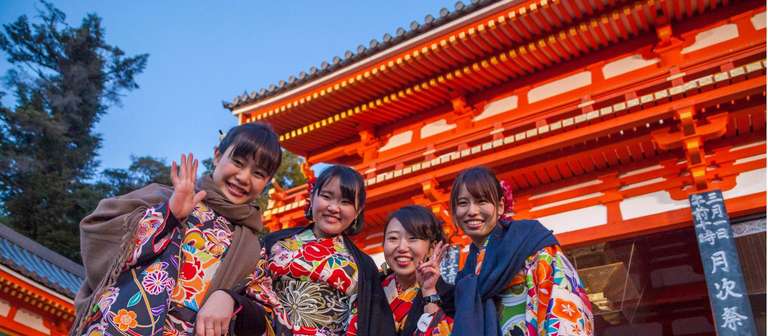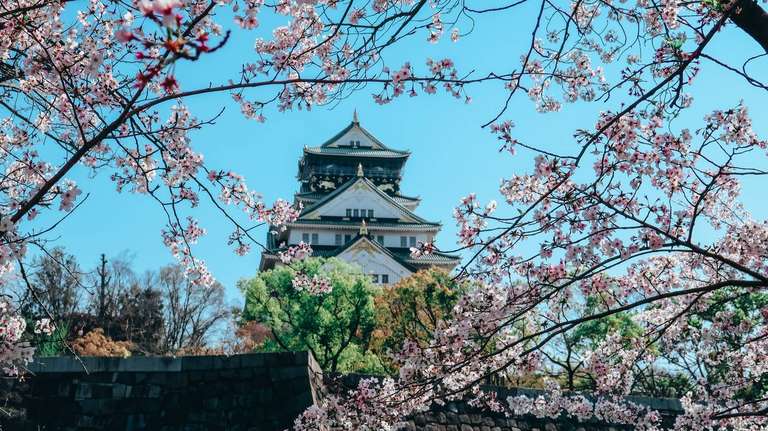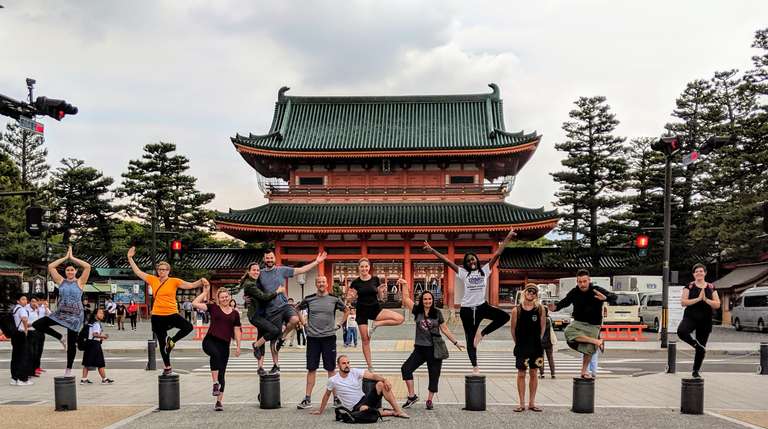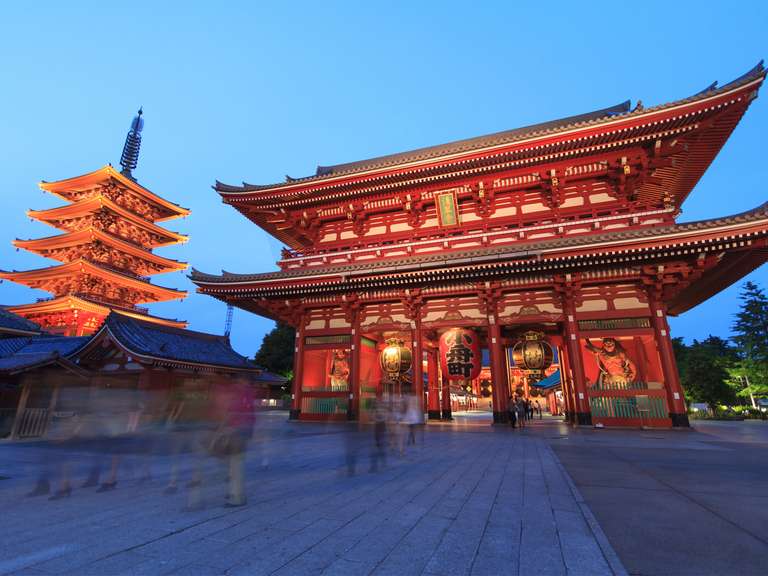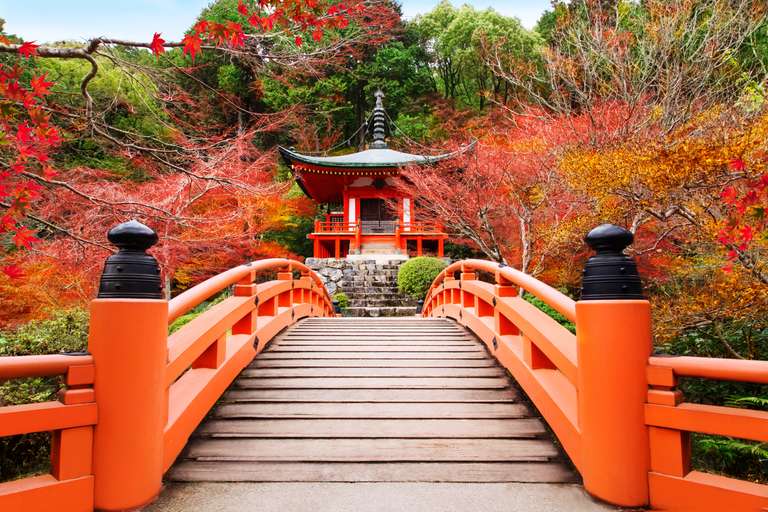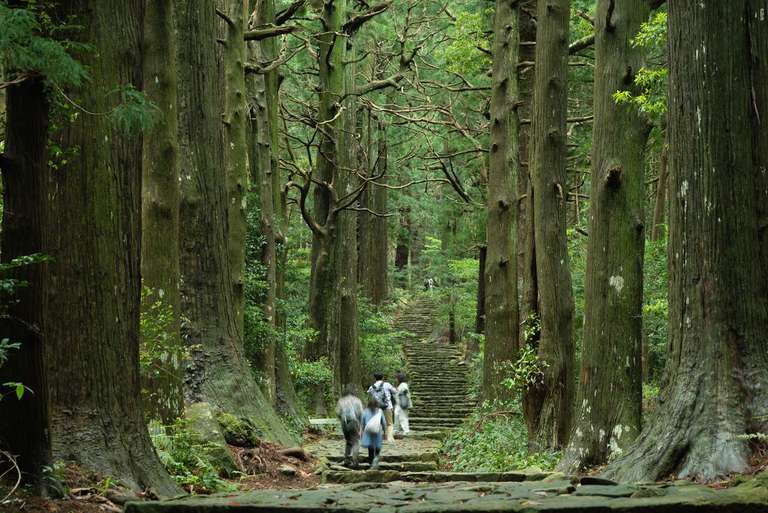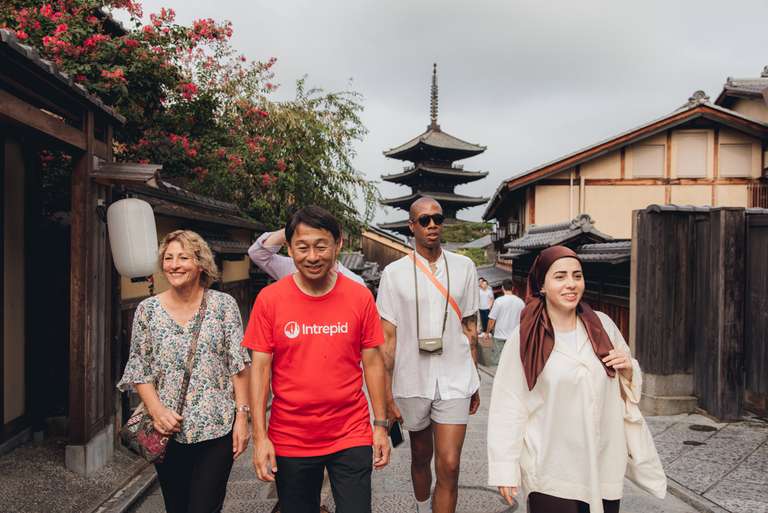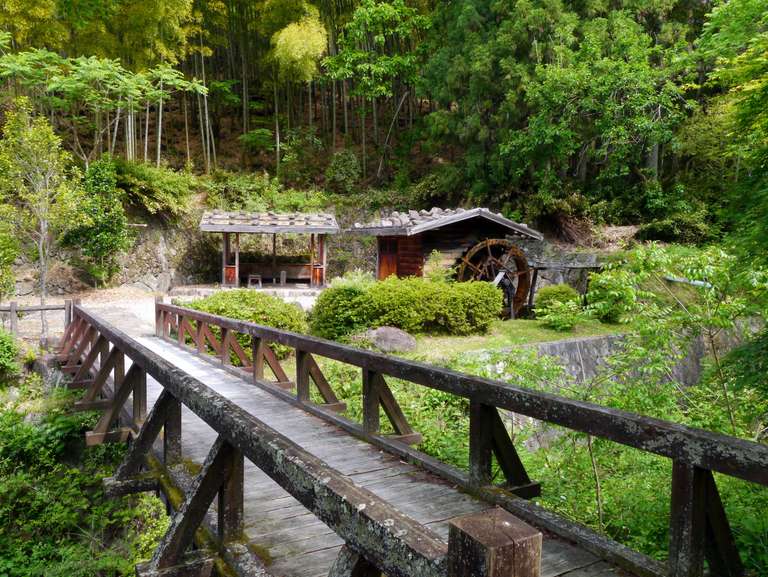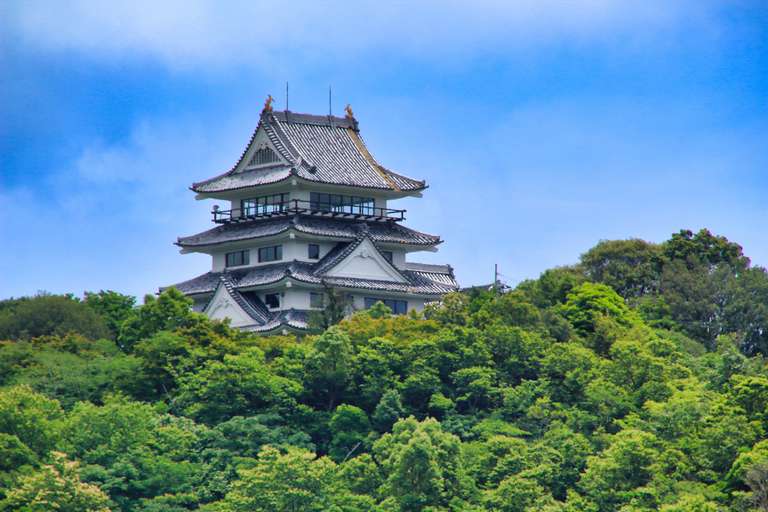Trekking in Japan: The 6 Best Multi-day Hiking Trails

- Saadet A
- From
- Saadet A
- From
- Jeremy T
- From
- Tayla T.
- From
The 6 best trails in Japan
1. Shikoku Pilgrimage
Located on the island of Shikoku, the Shikoku Pilgrimage (also known as the Shikoku 88 temple trail) is a famous, long pilgrimage route to 88 temples. This beautiful trail travels more than 1,200 km around the island, mostly following the coastline as that is where the majority of the temples are to be found. As well as visiting a plethora of beautiful and ancient shrines and temples, trekkers also get to enjoy fantastic scenery on the way. It is a very long route and can be time-consuming to hike in its entirety, so some visitors choose to break it up and instead attempt to visit all 88 temples over the course of their lifetime, returning again and again to hike amongst the beautiful nature.
|
Distance / days: |
1,200 km! It takes around 6 – 8 weeks to complete the whole trail, but it is possible to break it up into smaller chunks. There really is no set way to hike the trail so you can go for as long or as short a time as you like. |
|
Start / endpoint: |
Ryozen-ji in Naruto. Then head either clockwise or anticlockwise from there. |
|
Trail difficulty level: |
Mostly easy, although there are some steep ups and downs in the mountainous areas and the trail is long, so hikers need stamina to complete it. |
Best time to visit: It is possible to hike the Shikoku 88 temple trail any time of year, but summer can be a bit too hot and winter too cold. March to May, September and October are the most popular times due to the optimum weather conditions. This does mean, though, that there are a lot more people around.
Highlights:
- Gaze in awe at all of the amazing temples, shrines and pagodas that are to be found at the temple settlement of Mount Koya — the centre of Shingon Buddhism and another popular starting point.
- Collect an ink stamp from each temple you visit on the way and see how many you manage to get by the end of your trip.
2. Nakahechi trail in Kumano Kodo
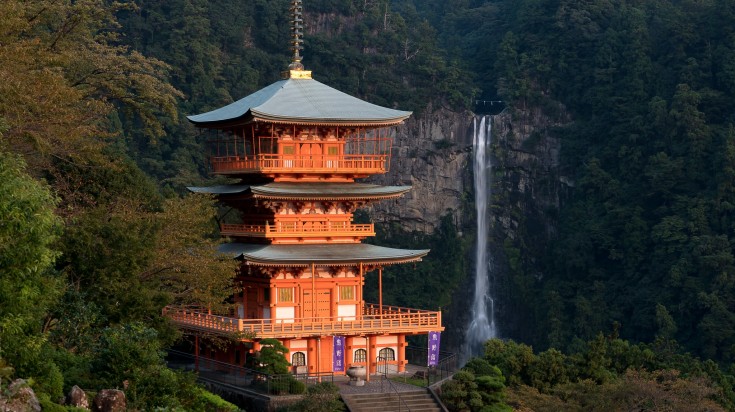
Admire one of the best-known waterfalls in Japan at Nachi-Taisha. The falls are said to have healing abilities. Photo by: Big Ben in Japan [ CC by SA- 2.0]
Listed on the UNESCO World Heritage Site, the Kumano Kodo pilgrimage is one of the most popular treks to do in Japan. Kumano Kodo is actually a series of seven different trails that lead you to the three famous Shinto shrines of Hongu Taisha, Hayatama Taisha and Nachi Taisha, which are collectively known as the Kumano Sanzan.
While there are a number of different routes that you can take, the most popular (and famous) route to follow is the Nakahechi Trail, also known as 'the Imperial Route' due to its history of hosting emperors, nobles and pilgrims. This lovely trail takes you through beautiful woodlands and mountain scenery until you reach the shrine of Hongu Taisha. From here, you can opt to continue hiking onwards to visit the other two shrines and the nearby hot springs.
|
Distance / days: |
40 km. It takes two or three days to hike the Nakahechi trail to Hongu Taisha, factoring in short breaks along the way. |
|
Trail difficulty level: |
Intermediate. There are steep ascents and descents on the trail so you have be moderately fit to complete it. |
|
Start / end point: |
The Nakahechi Trail starts at Takijiri-oji and ends at Hongu Taisha. |
Best time to visit: It is possible to hike Kumano Kodo any time of the year, but spring and autumn are the best seasons if you want to avoid extreme temperatures. In March and April you'll also get to enjoy the beautiful cherry blossoms and in October and November the forests look stunning as autumn sets in.
Highlights:
- Pay your respects at the ancient Hongu Taisha shrine and bask in the peaceful ambience after a trek successfully completed!
- Make sure to visit the Kumano Hongu Heritage Centre so you can learn all that there is to know about the Kumano Kodo trail and its amazing shrines.
3. Kamikochi-Yari-Hotaka Circuit
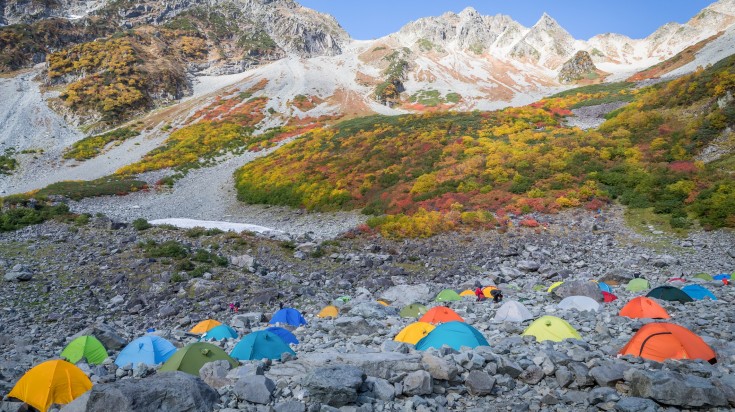
The Kamikochi-Yari-Hotaka Circuit takes willing trekkers on an amazing 34-kilometer journey through the northern Japanese Alps, surrounded by absolutely incredible views of craggy mountains, cloud-filled valleys and dramatic cliff faces. The scenery really is spectacular! The trail also summits Mount Yarigatake and Mount Okuhotaka-dake, both of which tower to over 3,000 metres in height. Despite some truly breathtaking views, it is certainly one of the toughest Japan walking trails and includes traipsing narrow mountaintop ridges, hurdling over boulders and walking along the cliff tops that look down over death-defying heights. That said, trekkers who manage the whole distance will certainly come away with an amazing sense of achievement.
|
Distance / days: |
34 km. The circuit takes three days to complete. |
|
Start / end point: |
The famous mountain resort of Kamikochi is both the start and end point of the route. |
|
Trail difficulty level: |
Very demanding. There are steep climbs and at times you'll have to pull yourself up ladders attached to rock walls and look down over death-defying heights. |
Best time to visit: Summer is the best time to hike this amazing circuit. In other seasons, there is either too much rain, too much snow, or all the huts are closed. July to October is the safest and nicest time of the year to visit.
Highlights:
- Feel your heart race as you climb up ladders, hold on to metal chains and clamber over boulders at Daikiretto where the mountainside drops away steeply to either side of you!
- Summit both Mount Yarigatake and Mount Okuhotaka-dake and bask in the glorious views that they offer up of the craggy mountains and plunging valleys before you.
4. Nakasendo Trail

Connecting Kyoto to Tokyo, the Nakasendo trail dates all the way back to the Edo period and is now one of the most popular trekking routes amongst locals and tourists alike as trekking in Japan grows in popularity. The historic trail winds through lovely mountainous countryside, passing traditional homes and inns, babbling brooks, ancient forests and more. While parts of it have become slightly touristy in recent years, most of the trail offers up an authentic look at Japanese history and culture. Trekkers can stop off at any one of the 69 post-towns that line the way.
|
Distance / days: |
530 km. About 30 days to complete in its entirety. It is possible to take a bullet train to various points along the way and then hike for a day or two. |
|
Start / endpoint: |
The traditional start and end points are Kyoto and Tokyo, although where you begin and end really depends on what you want to see and how long you want to hike. |
|
Trail difficulty level: |
Intermediate. While some parts of the trail can be steep, most of it is not too taxing. |
Best time to visit: Spring and autumn are the best time to visit as the rainy season in the summer makes trekking unpleasant and in winter it can snow quite heavily. As such March to May is the best time to go if you want to see wildflowers and cherry blossoms, and August to October to see the hues of autumn leaves.
Highlights:
- Hike up to the top of Torii Pass and bask in the beautiful views of Kiso Valley that stretch away before you.
- Stay the night in a ryokan – a traditional Japanese inn – and wallow in one of the hot springs that lie nearby before continuing your way along the Nakasendo trail.
5. Shinetsu Trail
Although the delightful Shinetsu trail only opened up in 2008, this ancient path has been used for centuries and it is actually one of the oldest in the whole of Japan. Weaving its way through the Sekida Mountain Range, it is the best trail to choose if you're after glorious woodland landscapes and it is particularly renowned for the amazing beech forests that can be found in the Satoyama region. As the trail connects lots of little villages and towns together, it also offers visitors the chance to delve into the rich local heritage and come away with a deeper understanding and appreciation for Japanese culture.
|
Distance / days: |
80 km. 5-6 days depending on how fast you hike.. As the trail is split into six sections, you can take a day to complete each section. |
|
Start / endpoint: |
Mount Madarao is the official starting point of the trail and Mount Amamizu is its endpoint. |
|
Trail difficulty level: |
Intermediate. While the hike is not particularly difficult, there are some steep climbs and it can get slippery in places when it has recently rained. |
Best time to visit: Spring and autumn are the best time to hike the Shinetsu trail, as in winter time it sees a lot of snow and the summers can be uncomfortably warm. April to June and September to October are the optimum times to visit if you want to see the forest in bloom or full of lovely autumnal colours.
Highlights:
- Hike to the top of both Mount Madarao and Mount Amamizu, which lie at each end of the trail, and enjoy the commanding views that they offer up of the lakes, forests and mountains around them.
- Amble peacefully through the centuries-old beech forests and marvel at the golden leaves falling all around you as autumn arrives.
6. Basho Trail

Witness the stunning landscape and nature that Basho has beautifully described in his poems. Photo by: ChiefHira [ CC by SA 3.0]

Don't miss Uramino-taki, the waterfall in Nikko that features in Basho's haiku. Photo by: S Shinohal [ CC by SA 3.0]
This marvellous trail is absolutely lovely to wander along and, on the way, you actually follow in the footsteps of Matsuo Basho – one of Japan’s earliest haiku masters. During the Edo period, the famous poet became disillusioned with life and so set off into the wild, not thinking that he would ever return. The beautiful nature and stunning landscapes which he wandered through reinvigorated him, however, and many of his most famous poems are found in his book, Narrow Road to the Deep North, which recounts his journey. As you amble peacefully along the Basho trail, you’ll certainly recognize the wonderful beech and cherry forests, lofty mountains and babbling brooks that he so eloquently writes about in his now centuries-old poems.
While Basho himself was gone for six months and covered over 2,500 kilometres, most people these days only hike small sections of the route. What’s certain, however, is that whatever part you choose to walk along, you’re sure to come across idyllic landscapes filled with poetic scenery for you to enjoy.
|
Distance / days: |
2,500 km! As this would take you months to complete in its entirety, you are better off walking smaller sections and then taking a bullet train between different stops along the way. |
|
Start / endpoint: |
The traditional route starts in Tokyo, takes you up to Matsushima in the north and then loops back down to Kyoto, the endpoint of the trail. |
|
Trail difficulty level: |
Intermediate. While the hike is genuinely quite easy to do, there are some steep parts in places and the distances involved can make it a bit of a challenge. |
Best time to visit: Spring or autumn is the optimum time to hike the Basho trail as you’ll either get to witness the beautiful cherry blossoms blooming or enjoy the lovely autumnal colours. Winter can be extreme and the rainy season can make hiking in a downpour unpleasant. As such, April to May and September to October are the best times to hike the route.
Highlights:
- Hike through some wonderful scenery and emerge to find the delightful Uramino-taki waterfall before you. Make sure to bring a copy of Basho’s poems with you so you can read about the waterfall at the same time!
- Ogle at the stunning views on offer from Yamadera Temple which so imperiously looks out over the mountains and valleys around it.
Safety tips
- While the trails in Japan are clearly signposted in both Japanese and English, it is a good idea to plan out your route in advance so you know exactly what to expect, how much distance you need to cover each day and where you're going to spend the night.
- Make sure to wear strong, sturdy shoes when embarking on your trekking adventure as this will help prevent any annoying little injuries.
- Hike with a companion or two just so that you have someone on hand if anything goes wrong..
- As you trek in Japan, make sure to take some water and snacks with you as some of the trails have large stretches where you won't come across anywhere to stock up on supplies.
- Bring insect repellent! Amidst all of the stunning nature, you will at times come across swarms of insects. Applying a generous amount of repellent will mean that you can relax each evening after your hike without having to itch like crazy.
- As the weather can change quite quickly in the mountains, it is essential that you pack appropriately so that you can comfortably deal with whatever weather comes your way. Bring a waterproof jacket with you even if it looks like being a lovely day.
- Some of the trails have quite steep inclines and descents, do it is best to take your time and not rush along the paths. As well as ensuring that you enjoy the beautiful nature all around you, walking at a slow and steady pace will make sure you don't risk injuring yourself.
- Charge your phone fully before starting off and save important numbers. Saving the local emergency numbers and the phone number of wherever you've booked to stay the night could be useful.
Packing tip
Just as important as planning out your route and deciding upon which trek you'd like to do is actually packing for it. As some of the treks we've highlighted above are quite tough, some taking around a month to fully complete, making sure you have the right equipment with you is absolutely crucial. To help you out, here's a useful guide on trekking equipment that will take you through all the equipment that you might need on your trek.
As you can see, trekking in Japan certainly is a special experience and there are absolutely loads of lovely trails for you to explore. While the scenery is stunning in itself, many of the trails lead you to incredible shrines and temples, offering up the perfect combination of history, culture and nature. With so many amazing treks and hikes in Japan for you to try and so much for you to see and do, it may just be time to book those tickets and start planning your unforgettable tour to Japan. Or better yet, connect with our top travel expert to help you plan a customized Japan trip ever!

